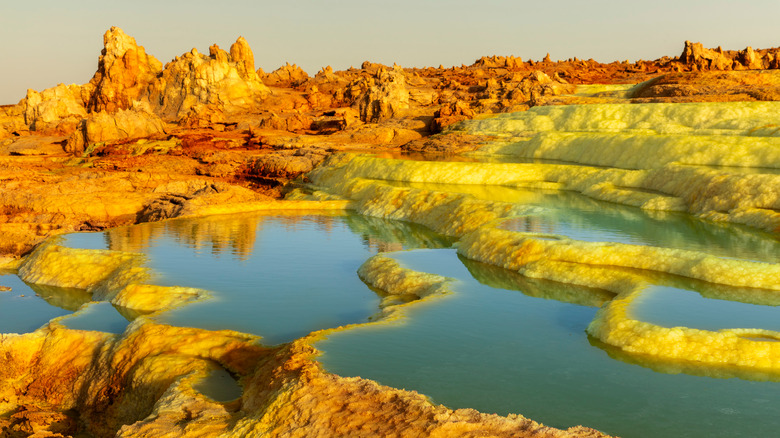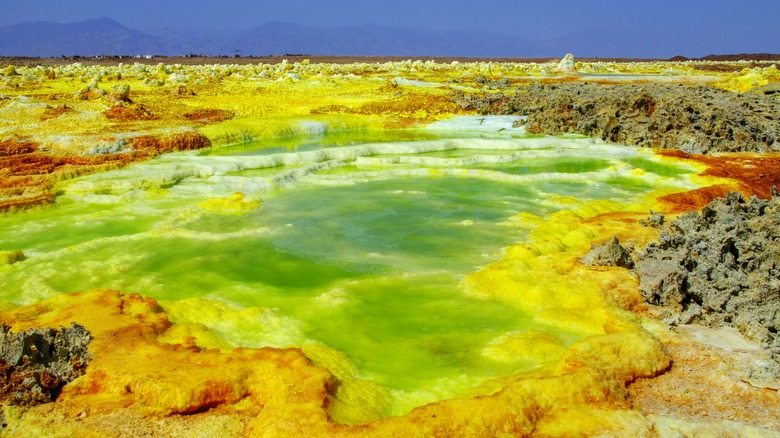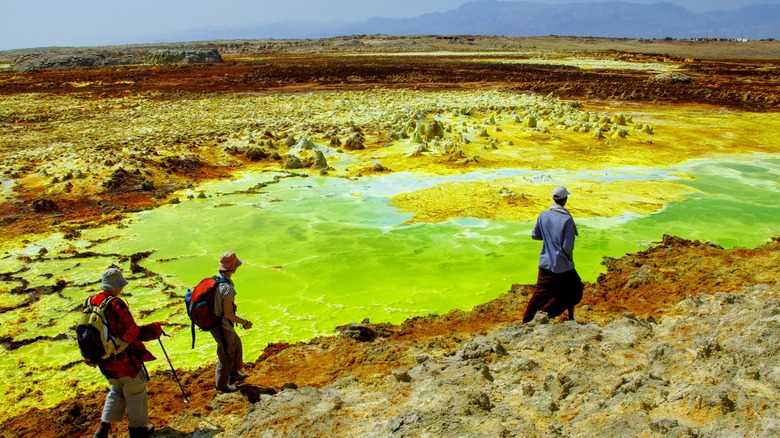This Desert In Ethiopia Is One Of The Most Dangerous Places On Earth
The Danakil Desert stretches across parts of Ethiopia, Eritrea, and Djibouti. Also known as the Danakil Depression, it's an arid, uninhabitable place, almost completely devoid of life. And yet, it's one of Ethiopia's biggest attractions.
Part of the Afar Triangle — a large geological depression — the Danakil Desert was described by British explorer Wilfred Thesiger as a "land of death," but the area has still managed to provide resources to those who live there. Miners have been extracting salt there for centuries, which was used as a form of currency in Ethiopia into the 20th century (via CNBC).
Despite its remote location and harsh conditions, scientists have found immense research value in the Danakil Desert. In the 1960s, researchers used the area to study plate tectonics. However, more recently, the focus of study has shifted to the field of astrobiology. In 2016, a team of researchers from the University of Bologna, Italy's International School of Planetary Sciences, and Ethiopia's Mekelle University studied whether microbes could inhabit the boiling pools of water found in the Danakil Desert, to see whether organisms like them could survive on Mars. As it turns out, such microbes are completely capable of surviving under these harsh conditions (via CNBC)
What makes the Danakil Desert so dangerous
According to CNBC, The Danakil Desert is one of the lowest places on Earth sitting at 400 feet below sea level. It's also one of the hottest, with temperatures capable of reaching 122 degrees Fahrenheit (50 degrees Celsius).
The Danakil Desert is the byproduct of volcanic activity, another factor that makes visiting it exceedingly dangerous. The air is filled with gases like sulfur and carbon dioxide which make it harmful to breathe, with some researchers believing that even short stays in the Danakil Desert can be detrimental to a person's health (via Orange Smile).
The vividly colored hot springs that the Danakil Desert is famous for present their own dangers. The water in these pools has an average pH of 0.2, which makes it more acidic than battery acid (via CNBC). Much like you'd find at other geothermal hotbeds like Yellowstone National Park, the crust surrounding these hot springs can be brittle, and not taking proper precautions can lead to taking a less-than-pleasurable dip in super-heated water.
Despite the danger, the Danakil Desert is still a big attraction
Despite the dangers — and perhaps in large part because of them — tourists still flock to the Danakil Desert. Typically a visit will start early in the morning, with a 4 a.m. departure from the town of Wilko. From there it's a three-hour journey by four-wheel drive convoy. However, a faster option is to take a helicopter which offers the bonus of seeing the seemingly alien landscape from above (via CNBC).
Once there, visitors can take in the natural beauty that the Danakil Desert has to offer, but it's not uncommon to see some dead insects and birds near the hot springs. They're often victims of the toxic gases in the area; reminders of the dangers present in the area and why the springs are sometimes called killer lakes.
The Danakil Desert's busy season runs from November through March, because it's during this time that temperatures are more manageable, but still reach well into the 90s (via CNBC).


